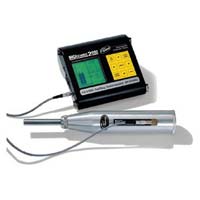
Rebound Hammer Test
Get Price Quote
Concrete Test Hammers are used for the non-destructive measurement of the concrete/mortar compressive strength and the control of the uniform concrete quality (in-situ concrete and prefabricated structures) as well as for detecting weak spots. The compressive strength (fc) is established by measuring the hardness (rebound value R) of the concrete surface and with the conversion curves. The rebound hammer is a surface hardness tester for which an empirical correlation has been established between strength and rebound number. The only known instrument to make use of the rebound principle for concrete testing is the Schmidt hammer, which weighs about 4 lb (1.8 kg) and is suitable for both laboratory and field work. It consists of a spring-controlled hammer mass that slides on a plunger within a tubular housing. The hammer is forced against the surface of the concrete by the spring and the distance of rebound is measured on a scale. The test surface can be horizontal, vertical or at any angle but the instrument must be calibrated in this position. Limitations and Advantages. The Schmidt hammer provides an inexpensive, simple and quick method of obtaining an indication of concrete strength, but accuracy of ±15 to ±20 per cent is possible only for specimens cast cured and tested under conditions for which calibration curves have been established. The results are affected by factors such as smoothness of surface, size and shape of specimen, moisture condition of the concrete, type of cement and coarse aggregate, and extent of carbonation of surface.

Rebound Hammer Test
Get Price Quote
Rebound hammer test is conducted to find out the compressive strength of concrete by using rebound hammer. The rebound of an elastic mass depends upon the hardness of the surface when it strikes. When the plunger of rebound hammer test is pressed against the surface of the concrete, the mass rebounds and the extent of such a rebound depends upon the surface hardness of the concrete. The spring-loaded hammer must travel with a consistent and reproducible velocity. The rebound distance of the steel hammer from the steel plunger is measured on a linear scale attached to the frame of the instrument. The tests can be performed in horizontal, vertically upward, vertically downward or any intermediate angled positions in relation to the surface. The devices are furnished with correlation curves by the manufacturer. ASTM C805 now states that these references to the relationship between the rebound hammer and compressive strength provided by the manufacturer shall be used only to provide indications of relative concrete strength at different locations in a structure. To obtain greater accuracy of test results, it is recommended that the user develops a correlation for the device on each concrete mixture design to be tested and at the intended test angle. Procedure to extract the appropriate result: Prior to the test, the rebound hammer should be tested against the anvil to get reliable results for which the manufacturer of the rebound hammer. indicates the range of readings on the anvil, suitable for different types of rebound hammer. On applying light pressure on the plunger, it will release it from the locked position and allow it to extend to the ready position for the test. Press the plunger to the surface of the concrete, the instrument being used perpendicular to the test surface. Apply a gradual increase in pressure until the hammer impacts. Take an average of about 15 readings.
Looking for Rebound Hammer Testing Services Providers

Rebound Hammer Testing Service
Get Price Quote
Rebound Hammer Testing Service, Hollock Wood Testing Service

Rebound Hammer Testing Services
Get Price Quote
Rebound Hammer Testing Services, Soil Testing Kit

Rebound Hammer Testing Services
Get Price Quote
Rebound Hammer Testing Services, hammer calibration services